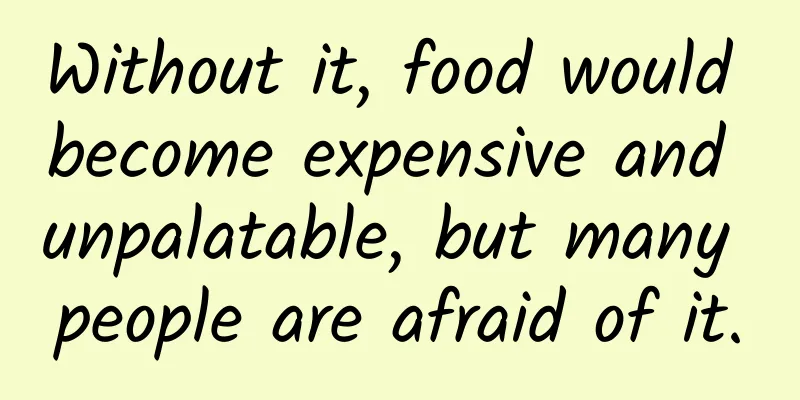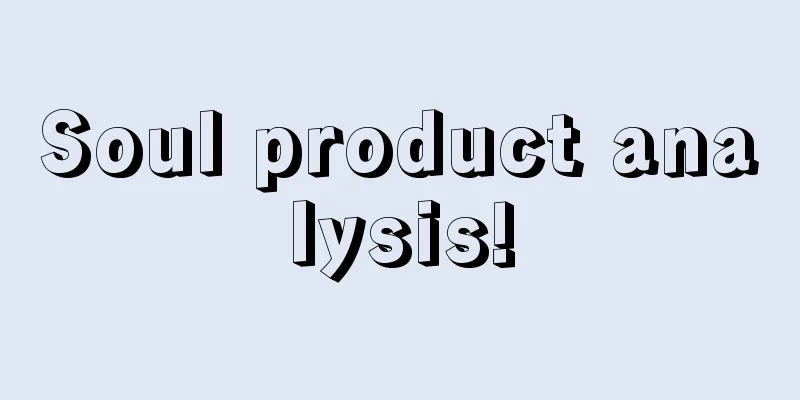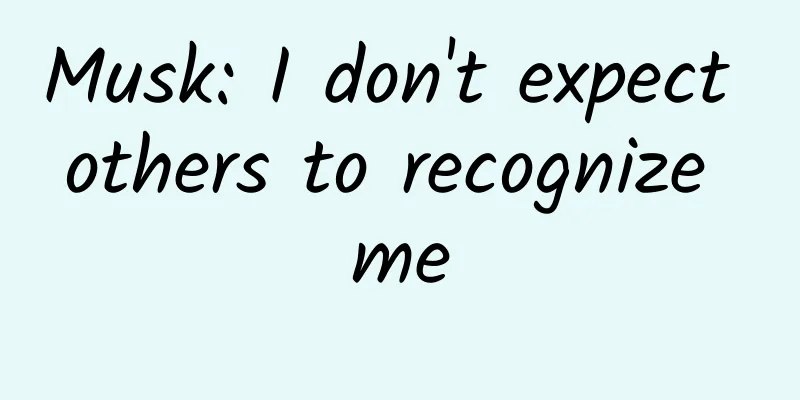Without it, food would become expensive and unpalatable, but many people are afraid of it.

|
As modern people pay more and more attention to health, various food safety issues have attracted everyone's attention. People once regarded food additives as a scourge, and major businesses also made a fuss about it. For a time, the market was flooded with various so-called "healthy products" with "zero additives". However, food additives really cannot be blamed for being "toxic". What are food additives? Food additives refer to artificial synthetic substances or natural substances added to food to improve food quality and color, aroma and taste, as well as for preservation, freshness preservation and processing needs. Food flavorings, base substances in gum-based candies, and processing aids for the food industry are also included. Copyright image, no permission to reprint The Codex Committee on Food Additives (CCFA) has set limits and ranges for food additives based on food safety toxicological evaluation and risk assessment, mainly based on the results of toxicological tests such as genetic toxicology tests, teratogenicity tests, and in vivo metabolism tests. There is a certain conversion factor (generally 100) when extrapolating the results of animal tests to doses suitable for humans. For example, in acute toxicity tests, the median lethal dose (LD 50) of animal tests is 10 g/kg, so the extrapolated limit for humans is 0.1 g/kg. Are food additives dangerous? It’s dangerous if you don’t use them! For modern food, food additives are not only important but also necessary, because without them, our lives would be more dangerous. Currently, diseases caused by eating food contaminated by pathogenic microorganisms have become the number one food safety issue worldwide. If preservatives and freshness-preserving agents are not used, meat products, baked goods, convenience foods, fruits and even foods or seasonings such as soy sauce can easily be contaminated by pathogenic microorganisms , ultimately endangering human health. Copyright image, no permission to reprint Food additives are an important part of the modern food industry. If used according to regulations, food additives are harmless to the human body and can effectively improve the quality of food and achieve preservation and freshness . It is precisely because of the development of food additives that there is a large supply of convenient foods, which brings great convenience to people's lives. If food additives are not added, most foods are either ugly, unpalatable, difficult to keep fresh, or expensive . In general, food additives are the soul of the food industry. Their existence is to make food look better, taste better, and have higher quality while ensuring safety. Without food additives, there would be no modern food industry and products. Food additives themselves are also developing and advancing. Major economies in the world are vigorously advocating the development of "safe, healthy, nutritious and multifunctional" food additives. Common ones now include natural antioxidants such as tea polyphenols and trehalose that prevents osteoporosis. Copyright image, no permission to reprint Next, we will analyze and explain several misunderstandings about food additives one by one. Myth 1 Confusing food additives with harmful "additives" Food additives are additives that are included in the national standard GB 2760-2014 "National Food Safety Standard-Food Additives Usage Standard" and are used in accordance with the regulations. Harmful "additives" can be divided into two categories:
Copyright image, no permission to reprint The second type of behavior is illegal in itself, and it is unacceptable no matter how much it is used. Therefore, for specific judgment, refer to the national standard GB 2760-2014 and carefully search and compare to make a judgment. Myth 2 Food without preservatives and zero additives is safer Except for some homemade foods, such as yogurt, bread and cake, which can be made and eaten immediately, any food that has been processed and transported in batches will be contaminated by microorganisms to a greater or lesser extent, which poses a potential risk of food poisoning. Copyright image, no permission to reprint The rational use of food additives can improve the nutritional value of food, improve food quality and stability. In addition, preservatives and antioxidants can inhibit pathogenic microorganisms and ensure food safety. If you blindly pursue food without preservatives and zero additives, you may lose the big picture because bacterial food poisoning is no joke. Myth 3 "No preservatives", "zero additives", "no artificial colors" means no food additives There are more than 2,600 types of food additives in 22 categories, so we cannot simply regard the limited types mentioned above as the entire food additives. In addition, there are basically no zero-additive foods on the market, and there will be more or less food additives in the food processing process. Myth 4 Consuming multiple food additives simultaneously can increase toxicity Some people may think that although food additives are within the standard range, is the total intake of so many foods every day safe? The answer is safe. GB2760-2014 stipulates the maximum usage of food additives in various foods. Its purpose is to ensure that when eating multiple foods in a day, the intake of food additives does not exceed the permitted daily intake (ADI). Copyright image, no permission to reprint The ADI value is evaluated by the national health department, that is, the amount of food additives that a person may consume daily based on body weight without causing health risks. Therefore, even if you eat many kinds of food in a day, you will not consume too much food additives. Myth 5 Natural food additives are safer than synthetic ones Whether it is natural food additives or synthetic food additives, they must all be evaluated for safety from the same starting line . Natural plants, animals, and natural enzyme preparations can also be contaminated in nature. If the extraction is not up to standard, their harmful ingredients can also be carried into the additives and contaminate the food. In addition, sweeteners are added to foods instead of sugar, which not only tastes sweet but also has lower calories than before. Some foods are currently advertised as "never adding any preservatives", but in reality they use high sugar and high salt to inhibit food spoilage. Sugar and salt are natural preservatives themselves, and large amounts of them can inhibit the growth of bacteria, such as in our pickled vegetables and candied fruits. However, long-term consumption of high-sugar and high-salt foods can easily lead to more serious consequences such as high blood pressure and diabetes. Copyright image, no permission to reprint Myth 6 Food additives have no nutritional value Many people believe that food additives have no nutritional value and that their intake does not bring any value to the human body. But this is not true. For example, infant formula contains a variety of food additives. By appropriately adding taurine, various vitamins, amino acids, mineral elements and other nutritional enhancers , infant formula can ensure that babies get reasonable and balanced nutrition at various stages of growth and development and meet the normal needs of human physiological activities. It can be seen that food additives are not completely nutritious, and nutritional enhancers have considerable nutritional value. Copyright image, no permission to reprint Myth 7 Pregnant women cannot eat ice cream because it contains food additives I often hear old people say that pregnant women can’t eat ice cream because it contains too many food additives. This has also been reported on TV. In fact, generally speaking, pregnant women are not recommended to eat ice cream because of the food additives, let alone the coldness, but because homemade ice cream has the risk of infection with Listeria , which is mainly found in raw eggs and has strong pathogenicity. Ordinary people will not have serious consequences if they eat it because of their strong resistance, but pregnant women are susceptible to it and are more likely to suffer miscarriage. Listeria, copyrighted image, unauthorized reproduction The food additives in ice cream are mainly to improve the taste, maintain the stability of the system , and some pigments. If they are not added, the ice cream will taste bad and will not be easy to preserve. Their existence is very necessary. And most of the food additives approved for marketing have almost no negative effects on the human body at a reasonable dose, and the same is true for pregnant women. Summarize Food additives are not a scourge, they have been blamed for too many illegal additives. We need to understand them scientifically and treat them rationally: food additives within the prescribed limit are safe . Food additives are part of our lives, we cannot avoid them and we don't need to avoid them. References: [1] GB/T2760-2014, National Food Safety Standard-Standard for the Use of Food Additives[S]. [2] Research on Consumers’ Risk Perception of Food Additives[J]. Social Science Perspectives, 2017, 7:83-85 [3] There is no need to demonize food additives[J]. Family Medicine, 2015, 2:84-84 [4] Research progress of nutritional enhancers[J]. Guangzhou Chemical Industry, 2016, 15:19-21 Author: Lin Feng This article is produced by Science Popularization China, produced by Lin Feng, and supervised by China Science Popularization Expo The cover image of this article is from the copyright gallery, and the image content is not authorized for reproduction |
>>: Why do Sichuan golden snub-nosed monkeys look so polite, while Tibetan macaques like to "rob"?
Recommend
Taking "Get" as an example, a brief analysis of how knowledge monetization can be combined with social networking
Taking " Get " as an example, the artic...
Beidou is officially launched. Why do we build Beidou?
Beidou officially launched Today (July 31), the c...
China Academy of Information and Communications Technology: In the first quarter of 2022, the domestic 5G access downlink rate ranked Shanghai at 462.93Mbps, ranking first
Recently, the China Academy of Information and Co...
How much does it cost to develop the Yanbian Logistics Mini Program?
WeChat Mini Program is an application that users ...
Talking about Android security 1——Activity hijacking and user prevention
1. Activity Scheduling Mechanism In the Android s...
600 million people are myopic, half of them are teenagers! Catch the "early warning signs" before children become myopic
There are about 600 million people with myopia in...
We also have a heavy ion accelerator for cancer treatment!
Audit expert: Luo Huiqian Researcher at the Insti...
How to bid and match Google/Baidu SEM keywords?
Bidding and matching methods are the two most imp...
The number of mobile Internet users in my country reached 986 million, with annual access traffic reaching 165.6 billion GB
As smartphone prices drop and mobile Internet bec...
How do algorithms influence user decisions?
In the past two days, articles about Internet tec...
A few things an investor wants to understand during these days of the COVID-19 pandemic
Perhaps no one expected that 2020 would hit us ha...
A brief discussion on the strategies and misunderstandings of APP promotion (iOS version)
As a veteran who has been in the APP promotion in...
How does “nuclear” produce “steam”?
Science Times reporter Ji Chunhong On the winding...
The Forbidden City: Let’s talk about those little-known little-known facts about the palace~
The Forbidden City is a beautiful red It brings t...
In 2020, the mobile phone giant will be reinstalled and "launched"
In the spring of 2020, the online channels of the...





![[Girls' Emotions] The art of falling in love with everyone: teach you how to quickly become a charming woman sought after by the opposite sex!](/upload/images/67cc26ad550b3.webp)



